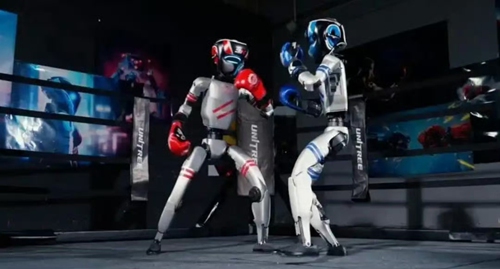
World’s First Humanoid Boxing Match: Unitree’s G1 Robots Throw Punches in a Historic Showdown
On May 25, 2025, the Hangzhou Mech Combat Arena in Hangzhou, China, became the epicenter of a groundbreaking moment in robotics and sports history: the world’s first humanoid robot boxing match. Organized by Chinese robotics firm Unitree Robotics as part of the China Media Group (CMG) World Robotics Tournament’s “Unitree Iron Fist King: Awakening!” event, this livestreamed spectacle featured Unitree’s 4.3-foot-tall G1 humanoid robots duking it out in a tournament-style competition. The event, which culminated in a dramatic knockout, showcased cutting-edge advancements in artificial intelligence (AI), motion capture technology, and robotic agility, while sparking global conversations about the future of human-machine interaction in competitive sports. This article explores the match’s key moments, technological feats, fan reactions, and the broader implications for robotics and entertainment.

The “Unitree Iron Fist King: Awakening!” event, held at 8:30 PM (GMT+8) on May 25, 2025, was a landmark in robotics, blending high-tech innovation with the thrill of combat sports. Four teams of human operators, each from diverse technical backgrounds, controlled Unitree’s G1 robots in real-time during a series of one-on-one boxing matches. The tournament also included exhibition sessions where the robots performed pre-programmed combat moves, such as straight punches, hook punches, sidekicks, and aerial spin kicks, captivating the audience with their human-like agility. The event concluded with a historic knockout, where one G1 robot landed a powerful blow, sending its opponent crashing to the canvas, as reported by Sidekick Boxing.
The match was preceded by a promotional buildup, including a demonstration at Hangzhou Qian Xuesen School on May 22, where G1 robots showcased their combat skills and endurance with a 40-minute jogging session, drawing enthusiastic cheers from students. Chu Yang, a marketing team member from Unitree, highlighted the robots’ control mechanisms: “The most common way is that the controller uses a simple controller to control the robot’s movements. We will reveal two other newly-developed control modes on the match.” These innovative control methods, unveiled during the event, underscored Unitree’s advancements in real-time tactical adaptability, setting the stage for a dynamic competition.
Unitree’s G1 robots, standing at 1.32 meters (4.3 feet) and weighing 35 kilograms, were the stars of the show. Designed for agility and affordability (priced at approximately $16,000), the G1 is equipped with advanced AI and motion control systems, utilizing LAFAN1 motion capture technology to replicate human movements with precision. Each robot features 23 degrees of freedom, with five articulation points per arm, six per leg, and one at the waist, allowing for fluid punches, dodges, and recovery from falls. The G1’s ability to perform complex maneuvers, such as kip-ups and side flips, was a testament to Unitree’s focus on full-body movement control, as seen in earlier demonstrations of dancing and kung fu moves.
Promotional videos released in April 2025 offered a glimpse of the G1’s capabilities, showing it sparring with a human and another robot. While slower and less fluid than human boxers, the G1 demonstrated remarkable resilience, quickly recovering after being knocked down. However, its movements were described as “herky-jerky” by IoT World Today, indicating that further refinements were needed. The event’s competitive matches relied on human operators remotely adjusting tactics in real-time, assessing the robots’ strength, balance, and adaptability, while exhibition sessions showcased autonomous sequences, blending pre-programmed moves with live control.
The use of LAFAN1 motion capture technology was pivotal, enabling the G1 to mimic human boxing techniques by mapping joint positions, speed limits, and actuator constraints. This technology, combined with high-quality human motion data, enhanced the robots’ coordination and precision, though their reaction times and dodging fluidity lagged behind human boxers. Gao Yuan, a coordinator at the Mech Combat Arena, emphasized the importance of self-balancing and smooth mobility, noting that the event served as a testbed for refining these capabilities.
The tournament was divided into two segments: a performance match, where robots showcased individual and group combat skills, and a competitive match, where four teams battled for supremacy. The performance session featured G1 robots executing stylized martial arts moves, including kung fu-inspired kicks, which sparked speculation about potential enhancements, as noted by NewsBytes. The competitive matches, however, stole the spotlight, with the final bout ending in a knockout that sent the crowd and online viewers into a frenzy. A post on X by @MarioNawfal described the scene: “4 teams. 1 arena. And a G1 robot just laid out its opponent—cold—in the world’s first-ever humanoid combat showdown.”
The knockout, reported by Sidekick Boxing, saw one G1 robot deliver a powerful blow, sending its opponent to the floor, marking the first-ever recorded knockout in humanoid robot combat. The robots’ ability to recover from falls, a highlight of Unitree’s training, was evident throughout, with one X post by @RT_com noting, “Unitree’s bots took brutal punches, crashed, and bounced back—months of grueling prep paid off.” The event’s blend of boxing and martial arts elements, including illegal kicks in traditional boxing rules, added a unique flair, reflecting the experimental nature of this pioneering competition.
The event generated significant buzz on X, with fans and analysts alike marveling at the technological spectacle. A post by @reborn_agi highlighted the match’s significance: “The match features robots executing live tactical maneuvers and evasions, marking a notable step in physical AI coordination and control.” Another user, @doollynoted, dubbed it “Real Steel! Humanoid robot boxing championship,” referencing the sci-fi film that inspired similar visions of robot combat. The knockout moment, shared by @HappyPunch, went viral, with the caption, “The first ever robot boxing championship held in China ended in a knockout 😂.”
Analysts praised Unitree’s technological strides but noted limitations. Popular Science described the event as a chance for robots to “fight back” after years of being tested in harsh conditions, while acknowledging the G1’s slower reaction times compared to humans. The Global Times hailed it as a “historic moment,” emphasizing China’s growing dominance in humanoid robotics, with the country’s market projected to reach $120 billion by 2030. However, some questioned the robots’ readiness, with IoT World Today noting their “clunky” movements, suggesting further training was needed for prime-time competition.
 The world’s first humanoid boxing match was more than a spectacle; it was a showcase of China’s advancements in AI and robotics, as noted by the Global Times. The event highlighted the potential for humanoid robots to extend beyond industrial applications into entertainment and sports, following China’s earlier experiments with robot soccer and a half-marathon in Beijing, where robots struggled but still drew attention. Unitree’s focus on affordable, agile robots like the G1 positions them as a leader in this space, with the company aiming to develop lighter, smarter robots for everyday life.
The world’s first humanoid boxing match was more than a spectacle; it was a showcase of China’s advancements in AI and robotics, as noted by the Global Times. The event highlighted the potential for humanoid robots to extend beyond industrial applications into entertainment and sports, following China’s earlier experiments with robot soccer and a half-marathon in Beijing, where robots struggled but still drew attention. Unitree’s focus on affordable, agile robots like the G1 positions them as a leader in this space, with the company aiming to develop lighter, smarter robots for everyday life.
The match also raised philosophical questions about human-machine interaction. Vocal’s Adnan Rasheed framed it as a human story of ambition, citing engineers teaching martial arts philosophy to machines and inspiring future generations. However, the event’s competitive nature, with robots programmed to “fight,” sparked debates about the ethics of robot combat sports. Some X users, like @0openscience0, verified the event’s authenticity, countering skepticism about its feasibility, while others pondered whether such competitions could one day rival human sports.
The tournament also served as a testing ground for data collection, a critical challenge in humanoid robotics. Motion capture, used extensively by Unitree, allows robots to replicate human movements with high precision, but acquiring high-quality data remains a hurdle for mass production. The event’s success, coupled with plans for a full-sized humanoid combat tournament in Shenzhen in December 2025, signals a growing interest in robot sports as both entertainment and a driver of technological innovation.
 The Future of Robot Combat
The Future of Robot Combat
The success of the “Unitree Iron Fist King: Awakening!” event has paved the way for future robot combat competitions. Unitree’s partnership with CMG and the planned Shenzhen tournament indicate a burgeoning industry, with Chinese firms like AgiBot and EngineAI joining the race to develop next-generation humanoids. The event’s global livestream, watched by thousands, underscored its appeal, with X posts like @AletihadEn calling it a “new era of Sci-Fi.”
For Unitree, the match was a milestone in showcasing the G1’s potential beyond research and hobbyist applications. The company’s focus on improving reaction times and fluidity, as noted in promotional materials, suggests that future iterations could rival human boxers in agility. For society, the event opens discussions about integrating robots into competitive domains, potentially reshaping sports and entertainment. As one X user, @heyshrutimishra, enthused, “Agile, fast, combat-ready. Yes, this is real!!!”
The world’s first humanoid boxing match was a landmark event that blurred the lines between science fiction and reality. Unitree’s G1 robots, with their advanced AI and motion capture technology, delivered a thrilling display of punches, kicks, and a historic knockout, captivating audiences worldwide. While the robots’ slower reactions highlighted areas for improvement, the event’s success underscored China’s leadership in humanoid robotics and the potential for robot sports to redefine entertainment. As Unitree and other firms push the boundaries of AI and robotics, the “Unitree Iron Fist King: Awakening!” has set the stage for a new era of human-machine competition, with the Shenzhen tournament in December 2025 poised to elevate the spectacle further.

